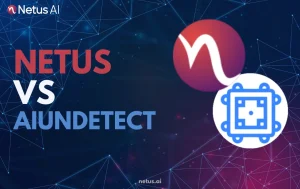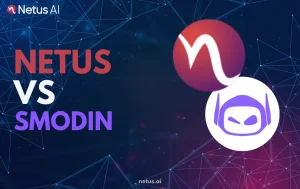
Netus vs. HumanizeAI | Netus.ai
Netus.ai vs. HumanizeAI: Which tool excels in AI bypassing, human-like rewriting or academic reliability? Dive into this detailed breakdown comparing features, accuracy or use cases.
Can an AI Content Detector Detect ChatGPT Blog Posts?

Content writer and editor for Netus.AI
Can an AI Content Detector Detect ChatGPT Blog Posts? AI-generated content is becoming increasingly prevalent in today’s digital landscape. However, with this rise in AI-generated content comes the concern of originality. ChatGPT is a popular AI language model that generates human-like text, making it a prime candidate for creating AI-generated content. The question arises: can an AI content detector detect ChatGPT blog posts?
AI content detectors are designed to detect plagiarism and ensure the originality of content. However, with the advancement of AI-generated content, it remains to be seen if these detectors are equipped to handle such content. Chat GPT essay generator, for instance, is capable of producing text that is difficult to differentiate from that written by a human. This raises the question of whether AI content detectors are capable of detecting AI-generated content that mimics human writing.
AI content detectors use machine learning algorithms and natural language processing techniques to analyze and classify text data. Machine learning algorithms enable the AI content detector to learn from the data and improve its accuracy over time. Natural language processing techniques help the AI content detector to understand the context and meaning of the text, which is essential for accurate classification.
The AI content detector uses a combination of supervised and unsupervised learning techniques to classify the text. In supervised learning, the AI content detector is trained on a labeled dataset of text data, where each data point is labeled with its corresponding category. In unsupervised learning, the AI content detector learns to identify patterns and relationships in the data without any prior knowledge of the categories.
One of the major challenges in developing AI content detectors is achieving high accuracy and precision. Accuracy refers to the ability of the AI content detector to correctly classify the text data into the right category. Precision refers to the ability of the AI content detector to avoid false positives, which are instances where the AI content detector incorrectly classifies the text data into a category that it does not belong to.
False positives and false negatives are common challenges in AI content detectors. False positives occur when the AI content detector incorrectly identifies text data as belonging to a particular category when it does not. False negatives occur when the AI content detector fails to identify text data as belonging to a particular category when it does.
To improve the accuracy and precision of AI content detectors, developers use various techniques such as feature selection, model optimization, and data augmentation. Feature selection involves selecting the most relevant features from the text data that are most informative for classification. Model optimization involves fine-tuning the parameters of the machine learning algorithm to improve its performance. Data augmentation involves generating additional data to improve the diversity and quality of the training dataset.
Overall, AI content detectors play an important role in identifying and classifying text data. With the help of machine learning and natural language processing techniques, AI content detectors can accurately classify text data into the right categories, although there are still challenges to overcome in achieving high accuracy and precision.
ChatGPT is a language model developed by OpenAI that is capable of generating human-like responses to text inputs. Its ability to generate coherent and contextually relevant responses has made it popular for use in chatbots and other conversational AI applications. However, the use of ChatGPT in generating blog posts has raised concerns about the authenticity of the content.
AI content detectors have been developed to identify patterns that are indicative of machine-generated content. These patterns include repetitive phrases, unnatural sentence structures, and a lack of coherence between sentences. ChatGPT-generated content can be identified by these patterns, as well as the presence of certain keywords and phrases that are commonly used by the model.
Recent advancements in generative AI have led to the development of more advanced language models, such as GPT-3 and GPT-4. These models are capable of generating even more coherent and contextually relevant responses than ChatGPT. However, they also pose a greater challenge for AI content detectors, as their outputs are less distinguishable from human-generated content.
Despite these advancements, AI content detectors continue to improve in their ability to identify machine-generated content. As the technology continues to evolve, it is likely that these detectors will become even more effective at identifying content generated by advanced language models like GPT-3 and GPT-4.
In conclusion, while ChatGPT-generated content can be identified by certain patterns and keywords, the use of more advanced language models like GPT-3 and GPT-4 presents a greater challenge for AI content detectors. However, with continued advancements in technology, it is likely that these detectors will continue to improve in their ability to identify machine-generated content.
Academic integrity is a crucial aspect of education and research. It involves maintaining honesty, trust, and responsibility in all academic work. It is essential to ensure that all the work submitted is original, authentic, and free from plagiarism. Plagiarism can have serious consequences, including academic penalties, legal action, and damage to one’s reputation.
AI content detectors can play a crucial role in promoting academic integrity by detecting and identifying any instances of plagiarism. This can help to maintain the credibility of academic work and ensure that students and researchers are held accountable for their work.
Originality and authenticity are also vital in the world of digital marketing and publishing. In a world where content is king, it is essential to ensure that all content is original and authentic. This helps to establish trust with readers and build a loyal audience.
AI content detectors can help to ensure that all content published is original and not copied from other sources. This can help to protect the reputation of publishers and ensure that readers are getting accurate and reliable information.
In conclusion, originality and authenticity are essential in both academic and digital publishing contexts. AI content detectors can help to promote these values by detecting instances of plagiarism and ensuring that all content is original and authentic. By maintaining these values, we can ensure that education and research remain credible and that digital publishing remains trustworthy.
AI detectors are becoming increasingly popular as a means of detecting plagiarized or copied content. Some of the most popular AI detectors on the market include Turnitin, ContentDetector.ai, Originality.ai, and Plagiarism Checker. These detectors use advanced algorithms to analyze text and identify any similarities with other sources on the internet.
Turnitin is one of the most widely used plagiarism detection tools in the academic world. It is an API-based tool that is used by thousands of institutions worldwide. Turnitin compares submitted papers against a vast database of academic and web content to identify any similarities.
ContentDetector.ai and Originality.ai are two popular AI detectors that use machine learning algorithms to analyze text and identify any similarities. These tools are designed to help businesses and individuals identify any instances of plagiarism or copyright infringement.
Plagiarism Checker is another popular AI detection tool that uses advanced algorithms to analyze text and identify any similarities with other sources on the internet. It is a free tool that is widely used by students, teachers, and professionals to check for plagiarism.
There are both free and paid AI detection services available on the market. Free services like Plagiarism Checker are a great option for those on a budget or for students who need to check their work for plagiarism. However, free services may not be as accurate as paid services, and they may have limitations on the number of checks that can be performed.
Paid services like Turnitin, ContentDetector.ai, and Originality.ai are more accurate and offer more advanced features, but they can be expensive. These services are typically used by businesses and academic institutions that need to check large volumes of content for plagiarism.
In conclusion, there are a variety of AI detection tools and technologies available on the market that can help identify instances of plagiarism or copyright infringement. Whether you choose a free or paid service will depend on your needs and budget.
As AI content detectors become more prevalent, educators and marketers face challenges and considerations in ensuring their content meets guidelines and standards.
Educators must ensure that their content is appropriate for their audience and meets academic standards. With the use of AI content detectors, educators can quickly identify any potential issues and make necessary revisions. However, educators must also be aware of the limitations of AI content detectors and should not rely solely on them to identify all issues.
Marketers must ensure that their content is engaging, informative, and meets the guidelines set by their organization. With the use of AI content detectors, marketers can quickly identify any potential issues that may harm their brand reputation. However, marketers must also be aware of the limitations of AI content detectors and should not rely solely on them to identify all issues.
With the increasing demand for content at scale, AI content detectors can be a valuable tool for educators and marketers. However, it is important to note that AI content detectors may not be able to identify all issues, particularly in cases where the content is highly specialized or technical.
Academic institutions must ensure that their content meets academic standards and guidelines. With the use of AI content detectors, academic institutions can quickly identify any potential issues and make necessary revisions. However, academic institutions must also be aware of the limitations of AI content detectors and should not rely solely on them to identify all issues.
One of the challenges faced by educators and marketers is the potential for false positives. AI content detectors may flag content as inappropriate or inaccurate, even if it is not. Additionally, AI content detectors may not be able to identify issues with highly specialized or technical content.
Educators and marketers should have access to support and resources to help them navigate the use of AI content detectors. This may include training on how to use the tools effectively and how to interpret the results.
Educators and marketers should follow guidelines and standards set by their organization and industry. This includes guidelines on appropriate language, tone, and accuracy. AI content detectors can be a valuable tool in ensuring that these guidelines are met, but they should not be relied upon solely.
In conclusion, AI content detectors can be a valuable tool for educators and marketers in ensuring that their content meets guidelines and standards. However, it is important to be aware of the limitations of these tools and to not rely solely on them to identify all issues.

Netus.ai vs. HumanizeAI: Which tool excels in AI bypassing, human-like rewriting or academic reliability? Dive into this detailed breakdown comparing features, accuracy or use cases.

Netus.ai vs. BypassAI: Which tool excels in AI bypassing, human-like rewriting or academic reliability? Dive into this detailed breakdown comparing features, accuracy or use cases.

Netus.ai vs. AIUndetect: Which tool excels in AI bypassing, human-like rewriting or academic reliability? Dive into this detailed breakdown comparing features, accuracy or use cases.

Netus.ai vs. AIUndetect: Which tool excels in AI bypassing, human-like rewriting or academic reliability? Dive into this detailed breakdown comparing features, accuracy or use cases.

Netus.ai vs. Paraphraser: Which tool excels in AI bypassing, human-like rewriting or academic reliability? Dive into this detailed breakdown comparing features, accuracy or use cases.

Netus.ai vs. Smodin: Which tool excels in AI bypassing, human-like rewriting or academic reliability? Dive into this detailed breakdown comparing features, accuracy or use cases.
@ 2024 Netus AI.